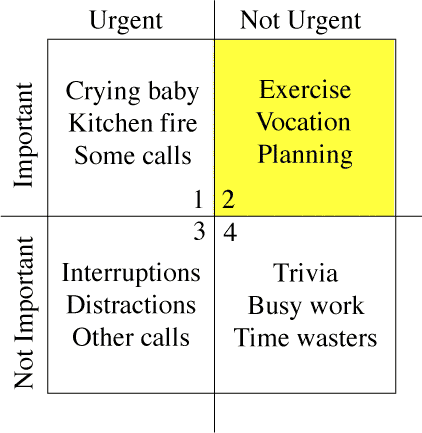How I get to Inbox Zero by jgn on Wednesday, January 18, 2017 in Uncategorized
So I was reading the latest in Samuel A. Rebelsky's saga on getting to Inbox zero, and I thought I'd mention how I do it.
I seem to get about 200 work emails / day, and in my personal email, maybe 150. Much of it is unimportant. Some of it is urgent. My Inbox Zero strategy is about marking the important items with a star, doing the urgent items right away, and archiving the rest: A bit like the Eisenhower box (from Wikipedia):

I make a fairly modest use of labels, largely because most of my email is forgettable and I can usually find what I want with search. For almost all of my labels, I bypass the Inbox. I figure that if I have a label for it, I can rely on the visual cue (label name bolding) that there is something unread. I rarely delete email.
I'm doing this with GMail. The key feature I depend on is that I can set a checkbox for all of the email that I'm reviewing. It also helps that in GMail the checkbox selections are sticky, so that I can apply sequentially more than one operation to the same collection.
- I quickly skim all of the subject lines for new mail in my inbox.
- I decide if I'm going to archive more than I keep.
- If I think I'm going to archive more than I keep, I select the checkbox indicating that I want to do something with all of the emails.
- Then, beginning oldest to newest, I check or uncheck each of the emails depending on the subject. If I think I'm archiving most, then if there's something "interesting," I will uncheck it. (And if I'm mostly keeping, I'll check it to indicate that I'm archiving.) If I see something that is "interesting" in this stage that I don't intend to read right away, I will star it. For me, "star" means: come back later. By the way, I start with the oldest so that if there's something urgent that's becoming stale I can respond to it right away (and I will typically respond to it during this phase).
- Then I mark all checked emails as "read," and then I archive all checked emails. It is important that I mark the emails as "read" so that if an email comes in on a very old thread and it's buried in a long list, I can surface it with "label: unread" without what I would consider false matches.
- At this point in the process, I have a small collection of emails that I think I need to actually read.
- Now I will read these typically from newest to oldest. Why? Because I've already dealt with the urgent-but-possibly-stale messages, so the priority at this point is usually responding rapidly to my correspondents who wrongly think email is the right tool for quasi-conversational real-time communications. Sometimes I will tell them to use Flowdock, GChat, or text messaging but the effort is rarely worth it.
- If there's an obvious action for the email, I do it. If it is "interesting" and can be handled later, I start it.
- At this point I archive everything except for new email that has appeared since I began the effort to get to Zero.
- Even if there are a couple of brand new emails, I consider this Inbox Zero.
In short: Starting with subject lines only: Important and urgent? Deal with it. Important but not urgent? Star it and come back later. Everything: Archive.
Periodically (about twice/day) I will go into the starred email and see if there's anything that I want to attend to. Every few days I will archive everything that is starred on the principle that if I haven't done anything with them, they are actually not important.
Since you got this far, here's the mod revival song "Your Side of Heaven" by Back to Zero.
comments powered by Disqus